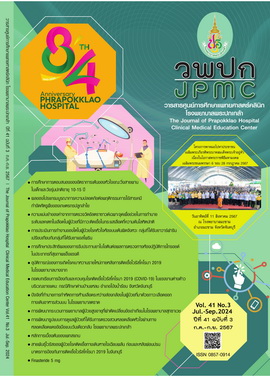Viral Etiology of Acute Respiratory Infections, Before and After Relaxed COVID-19 Preventative Measures in Chanthaburi Province, Thailand
Main Article Content
Abstract
Viruses are highly contagious and can evolve rapidly, leading to the emergence of new strains with different antigenic properties. These variations can influence the transmission dynamics and severity of viral diseases. The surveillance data indicates that the most prevalent viruses causing acute respiratory infections are rhinovirus/enterovirus, influenza, respiratory syncytial virus, SARS-CoV-2, and parainfluenza virus. After the relaxation of measures implemented to prevent coronavirus disease 2019 (COVID-19), the surveillance data revealed a statistically significant increase in the incidence of influenza (9.9%; 95%CI 6.0-13.7) and human metapneumovirus (5.9%; 95%CI 3.9-8.0). Conversely, there was a statistically significant decrease in the incidence of SARS-CoV-2 infection (14.8%; 95%CI (-18.9)-(-10.5)). A benefit of this analysis is the identification of the incidence of acute respiratory infections caused by non-influenza viruses. Studying the genetic metagenomics of viruses in the environment is challenging, yet crucial for advancing knowledge and developing surveillance systems for new viral strains and vaccines to prevent future outbreaks.
Article Details

This work is licensed under a Creative Commons Attribution-NonCommercial-NoDerivatives 4.0 International License.
References
Gandhi L, Maisnam D, Rathore D, Chauhan P, Bonagiri A, Venkataramana M. Respiratory illness virus infections with special emphasis on COVID-19. Eur J Med Res [Internet]. 2022 [cited 2023 Nov 18];27(1):236. Available from: https://www.ncbi.nlm.nih.gov/pmc/articles/PMC9641310/pdf/40001_2022_Article_874.pdf
Dhand R, Li J. Coughs and sneezes: their role in transmission of respiratory viral infections, including SARS-CoV-2. Am J Respir Crit Care Med 2020;202:651-9.
Short KR, Kedzierska K, van de Sandt CE. Back to the future: lessons learned from the 1918 influenza pandemic. Front Cell Infect Microbiol [Internet]. 2018 [cited 2023 Nov 18];8:343. Available from: https://www.ncbi.nlm.nih.gov/pmc/articles/PMC6187080/pdf/fcimb-08-00343.pdf
Hay AJ, McCauley JW. The WHO global influenza surveillance and response system (GISRS)-A future perspective. Influenza Other Respir Viruses 2018;12:551-7.
Chittaganpitch M, Waicharoen S, Yingyong T, Praphasiri P, Sangkitporn S, Olsen SJ, et al. Viral etiologies of influenza-like illness and severe acute respiratory infections in Thailand. Influenza Other Respir Viruses 2018;12:482-9.
Ndeh NT, Tesfaldet YT, Budnard J, Chuaicharoen P. The secondary outcome of public health measures amidst the COVID-19 pandemic in the spread of other respiratory infectious diseases in Thailand. Travel Med Infect Dis [Internet]. 2022 [cited 2023 Nov 18];48:102348. Available from: https://www.ncbi.nlm.nih.gov/pmc/articles/PMC9065650/pdf/main.pdf
Ministry of Public Health. Epidemiological surveillance report 506. 2022 [cited 2024 Mar 10]. Available from: http://doe.moph.go.th/surdata/506wk/y65/d15_5265.pdf
Ministry of Public Health. Epidemiological surveillance report 506. 2023 [cited 2024 Mar 10]. Available from: http://doe.moph.go.th/surdata/506wk/y66/d15_5366.pdf
Avgoustou E, Spyridaki A, Pothitos G, Papadopoulos A, Kois S, Vassilara F. Enterovirus-rhinovirus-induced acute respiratory distress syndrome in adults: a case report and short literature review. Case Rep Infect Dis [Internet]. 2023 [cited 2024 Mar 10];2023:8887955. Available from: https://www.ncbi.nlm.nih.gov/pmc/articles/PMC10637844/pdf/CRIID2023-8887955.pdf
Giardina FAM, Piralla A, Ferrari G, Zavaglio F, Cassaniti I, Baldanti F. Molecular epidemiology of rhinovirus/enterovirus and their role on cause severe and prolonged infection in hospitalized patients. Microorganisms [Internet]. 2022 [cited 2024 Mar 10];10(4):755. Available from: https://www.ncbi.nlm.nih.gov/pmc/articles/PMC9030097/pdf/microorganisms-10-00755.pdf
Essaidi-Laziosi M, Royston L, Boda B, Pérez-Rodriguez FJ, Piuz I, Hulo N, et al. Altered cell function and increased replication of rhinoviruses and EV-D68 in airway epithelia of asthma patients. Front Microbiol [Internet]. 2023 [cited 2024 Mar 10];14:1106945. Available from: https://www.ncbi.nlm.nih.gov/pmc/articles/PMC10014885/pdf/fmicb-14-1106945.pdf
To KKW, Yip CCY, Yuen KY. Rhinovirus-from bench to bedside. J Formos Med Assoc 2017;116(7):496-504.
Hamid K, Ali M, Devasahayam J. Acute respiratory distress syndrome secondary to enterovirus-human-rhinovirus infection in an adult. Cureus [Internet]. 2022[cited 2024 Mar 12];14(6):e26475. Available from: https://www.ncbi.nlm.nih.gov/pmc/articles/PMC9247263/pdf/cureus-0014-00000026475.pdf

